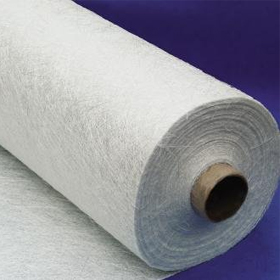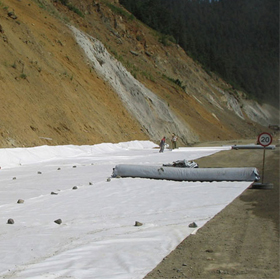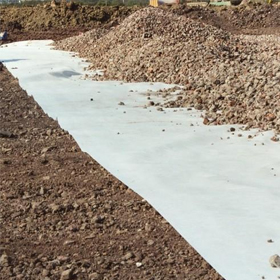Non-Woven Geotextile
Nonwoven geotextiles are produced with regular filament yarn or short-staple fiber. The fibers are joined by chemical, thermal-mechanical, mechanical, or any combination of these techniques. The thickness of ground fibers created through mechanical interlocking and thermal bonding ranges from 0.5-1 millimeter. The chemically-bonded nonwoven is approximately around 3 millimeters.
It is a new technology in high-tech processes in which filaments or synthetic polymer fibers are extruded continuously and laid in moving conveyor belts. The mass of fibers or filaments are needle punched where filaments are mechanically bound through a set of tiny needles that allow fibers to be connected by heat or pressure at the point of contact within an unwoven mass.
Nonwoven geotextiles are made through the process of bonding, not weaving, materials. This is accomplished through the application of heat or chemicals or by other methods such as needle punching. Nonwoven fabrics are generally composed of synthetic materials and are used extensively in filtering and separation applications. Contrary to their woven counterparts nonwoven materials aren't as a material for reinforcement or stabilization tasks, though they're a good option for specific applications such as protecting geomembrane liner systems from interior or exterior penetrations.
- Filtration.
- Separation.
- Drainage.
- Permeable.
- Classified by weight.
Geotextiles made of non-woven materials have their own purposes and applications. They are utilized for various reasons based on their durability drainage, durability, and strength. They can also be made by the needle punching method. This means you can make use of barbed needles to create geotextile fabrics that are permeable.
- The fabric is in a position to stop erosion.
- Highly durable and flexible.
- It is manufactured with the latest technology to meet the demands of the market and also the performance of customers.
- They also have durability and flexibility.
- The level of uniformity has reached its maximum point.
Non-woven Geotextile has numerous applications and is currently used in a variety of civil engineering projects, such as railways, airfields, and roads embankments, retaining structure embankments reservoirs, canals, banks, dams coastal engineering, as well as the construction silt fencing, or tubes. Geotextiles are typically installed on the tension surface to reinforce the soil. Geotextiles can also be used for sand dune armoring in order to protect coastal properties in the uplands from wave action and flooding.
Because of their capacity to let moisture pass through, geotextiles made of non-woven materials aren't the best choice for reinforcement or stabilization projects. Instead, they're best for applications involving the protection of drainage, separation, and filtering.
A high rate of water permeability also means that they won't decrease in strength with time, especially when used beneath the ground. Additionally, non-woven geotextiles can be less difficult to cut, making their use in specific industrial applications.
These fabrics are lighter than knitted fabrics, but for both, you're in a position to use one yarn. This allows you to work with the fabric and place them on the site. The effort and transportation costs are less.






